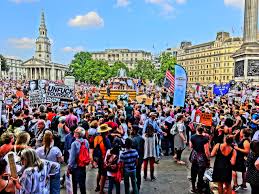Recent Trump Protest in London: Public Sentiment and Response

Introduction
The recent protests against former President Donald Trump in London underscore the ongoing political tensions and public sentiment regarding his leadership. As global news continues to highlight Trump’s influence on international affairs, the protests serve as a reflection of the divided opinions surrounding his policies and actions. Understanding the motivations and outcomes of these protests is essential in comprehending contemporary political climates both in the UK and abroad.
Details of the Protest
On October 21, 2023, thousands gathered in London’s central squares to voice their disapproval of Donald Trump, who was in the UK for a speaking engagement. The protest was organized by various activist groups, including ‘Stop Trump Coalition’ and ‘Don’t Believe the Hype’, aiming to bring attention to Trump’s controversial policies on immigration, climate change, and healthcare. Attendees held placards with messages such as “Not my President” and “Policies are Un-American”, highlighting the concerns many have about his rhetoric and approach to governance.
Law enforcement estimated that around 10,000 people participated in the protest, which was largely peaceful, though minor skirmishes were reported with counter-protesters supporting Trump. Police adjusted their presence to ensure safety while allowing freedom of expression among protesters. The event featured speeches from prominent activists and local political figures, further galvanising the crowd.
Public Response and Media Coverage
The protest received significant media coverage, both in the UK and internationally. News outlets focused on the scale of the demonstrations and the variety of voices represented. Social media also played a crucial role, with numerous posts and live updates that garnered worldwide attention, demonstrating the global relevance of Trump’s policies and the public’s response to them.
Conclusion
The recent Trump protest in London reflects not only the pervasive dissent against the former president’s administration but also a larger trend of activism as citizens engage with democratic processes. As similar protests and counter-protests are likely to continue in the lead-up to future elections, understanding public sentiment and the issues that motivate such mobilisations will be critical. Moving forward, it will be essential to monitor how these events influence political discourse and the potential implications for international relations in an increasingly interconnected world.
